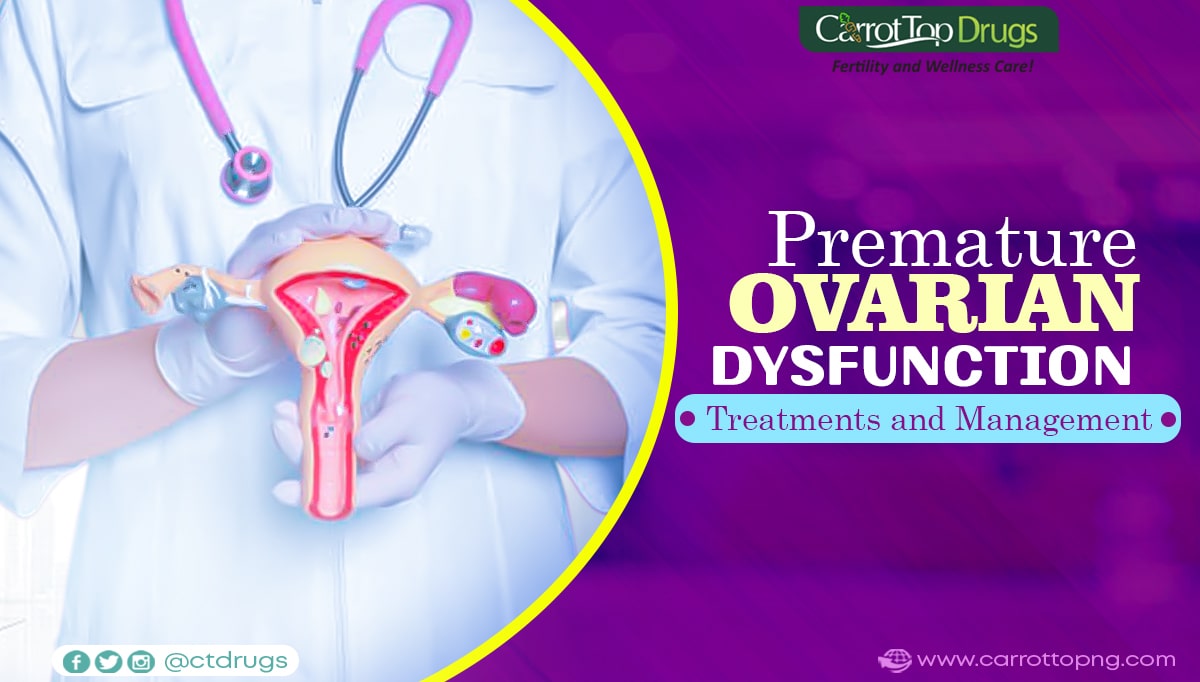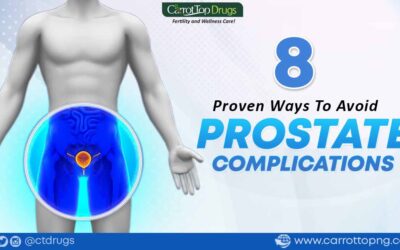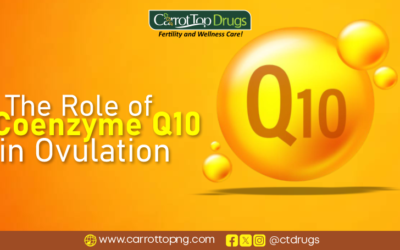Introduction
Premature ovarian dysfunction is a condition in which the ovary is not functioning properly. The function of the ovary is to produce hormones and release eggs. When the ovary fails to perform its function, the woman’s reproductive health is at stake.
In this article, we would thoroughly examine the symptoms, diagnosis, treatment options, and management.
Symptoms of Premature Ovarian Dysfunction
The symptoms of premature ovarian dysfunction can vary from woman to woman. But they include:
1. Irregular periods
Women with premature ovarian dysfunction may experience irregular periods. Worse still, the periods may stop altogether. Not seeing your period in a while could be a symptom of premature ovarian failure.
2. Hot flashes
Hot flashes are a common symptom of menopause, but can also occur in women with premature ovarian dysfunction.
3. Vaginal dryness
Vaginal dryness can occur due to decreased levels of estrogen. This can cause discomfort during intercourse. The walls of the vagina secrete mucus under the influence of estrogen. Estrogen will decrease due to ovarian failure.
4. Mood changes
Women with premature ovarian failure may experience mood changes, such as depression or anxiety. Hormones affect the mood of a woman.
5. Decreased fertility
POD can significantly reduce a woman’s fertility, making it more difficult to conceive. Without the ovary, there can be no fertilization.
Diagnosis of Premature Ovarian Dysfunction
The diagnosis of premature ovarian dysfunction usually involves a combination of blood tests, physical exams, and imaging tests. These tests can help determine the levels of hormones such as estrogen and follicle-stimulating hormone (FSH). These tests can be used to diagnose Premature Ovarian Failure.
Diagnosis of premature ovarian failure can be a complex process. The reason for this complexity is that there are many possible causes of the condition. In this article, we will discuss the various methods used to diagnose premature ovarian dysfunction.
1. Understanding the Symptoms
The first step in diagnosing premature ovarian dysfunction is to understand the symptoms. These can include:
- Irregular periods or no periods
- Hot flashes
- Night sweats
- Vaginal dryness
- Pain during sex
- Mood swings
- Difficulty concentrating
If you are experiencing any of these symptoms, it is important to see your doctor as soon as possible.
2. Medical History and Physical Exam
Your doctor will begin the diagnostic process by taking a detailed medical history. The physician would also perform a physical exam. This may include:
- Asking about your menstrual cycle and any changes you have noticed
- Asking about any other symptoms you may be experiencing
- Performing a pelvic exam to check for any abnormalities
3. Hormone Testing
Hormone testing is an important part of diagnosing premature ovarian dysfunction. This may include:
Follicle-stimulating hormone (FSH) test:
The follicle-stimulating hormone (FSH) test is particularly useful in the diagnosis of premature ovarian dysfunction. One of the key indicators of premature ovarian dysfunction is abnormally high levels of FSH in the blood. This is because the pituitary gland would try to compensate for the ovaries’ decreased ability to produce estrogen. An FSH level above 25 IU/L is generally considered diagnostic of premature ovarian failure.
In addition to the FSH test, other diagnostic tests may be necessary to confirm the diagnosis of premature ovarian dysfunction. These may include measuring other hormone levels such as estradiol and luteinizing hormone (LH). The doctor may as well use imaging studies to evaluate the ovaries.
While premature ovarian dysfunction is a relatively rare condition, affecting only about 1% of women, it can have significant impacts on a woman’s fertility and overall health. Therefore, early diagnosis and treatment are crucial. Depending on the underlying cause of the condition, treatment may include hormone replacement therapy, fertility treatments, or other interventions.
Estradiol test:
The estradiol test is another important diagnostic tool used to evaluate the functioning of the ovaries in women. The ovaries produce estradiol. It is responsible for regulating the menstrual cycle and supporting reproductive function.
Low levels of estradiol in the blood can indicate ovarian dysfunction, which can lead to irregular periods, infertility, and other reproductive problems. In addition to ovarian dysfunction, low levels of estradiol can also be a sign of other underlying health conditions such as polycystic ovary syndrome (PCOS) or Turner syndrome.
The estradiol test is typically carried out through a blood sample, similar to the FSH test. The test may be ordered as part of a routine gynecological exam or if a healthcare provider suspects that a patient may have a reproductive problem.
Depending on the underlying cause of the low estradiol levels, treatment may involve hormone replacement therapy, fertility treatments, or other interventions. In cases where the low estradiol levels are due to a more serious underlying condition such as Turner syndrome, additional testing and management may be necessary.
Luteinizing hormone (LH) test:
The luteinizing hormone (LH) test is another diagnostic tool used to evaluate the functioning of the ovaries in women. LH is a hormone produced by the pituitary gland that helps to regulate the menstrual cycle and ovulation.
Elevated levels of LH in the blood can be a sign of premature ovarian dysfunction. Similar to the FSH test, the pituitary gland increases the production of LH when the ovaries are not functioning properly to stimulate ovulation.
In addition to premature ovarian dysfunction, elevated levels of LH can also be a sign of other underlying health conditions such as PCOS or pituitary gland tumors.
The LH test is typically carried out through a blood sample, similar to the FSH and estradiol tests.
4. Genetic Testing
Genetic testing is a medical examination that can help identify if a particular genetic mutation or alteration is responsible for a specific medical condition or disease. In the case of premature ovarian failure, genetic testing can help identify whether genetic factors are contributing to the condition.
While the exact causes of premature ovarian dysfunction are not fully understood, genetic factors are known to play a role in some cases. Mutations in certain genes, such as FMR1, BMP15, and GDF9, have been linked to premature ovarian dysfunction.
Genetic testing for POD involves analyzing a person’s DNA to detect any mutations or alterations in the genes associated with the condition. This may involve taking a blood sample or a cheek swab to extract DNA from the cells.
Once the DNA sample is obtained, it is sent to a laboratory for analysis. The laboratory may use different techniques to analyze the DNA. Techniques such as DNA sequencing or genotyping. This is to identify any mutations or alterations that may be causing premature ovarian dysfunction.
Genetic testing for POD can provide valuable information about the underlying causes of the condition. This information can help doctors develop an appropriate treatment plan. It also helps doctors to provide genetic counselling to individuals and their families.
In some cases, genetic testing may also be useful for family planning. For example, if a person has a genetic mutation associated with POD, they may choose to undergo preimplantation genetic testing (PGT) during in vitro fertilization (IVF) to ensure that only embryos without the mutation are implanted.
In conclusion, genetic testing can be an essential tool for diagnosing and managing POD. By identifying any genetic factors contributing to the condition, doctors can develop a personalized treatment plan and provide valuable information for family planning.
5. Imaging Tests
POD can be diagnosed through various imaging tests, including ultrasounds and MRI scans.
Ultrasound is a commonly used imaging test for diagnosing POD. It uses high-frequency sound waves to produce images of the ovaries and other reproductive organs. This can help detect any abnormalities, such as cysts or tumors, that may be affecting the ovaries’ function.
MRI scans are another imaging test that can be used to diagnose POD. MRI uses powerful magnets and radio waves to produce detailed images of the ovaries and other internal organs. This can provide a clearer picture of any structural abnormalities. It can also detect changes in blood flow to the ovaries that may be contributing to POD.
Imaging tests can play a crucial role in diagnosing and monitoring POD. Early detection through imaging tests can also help prevent complications. This also helps to improve overall health outcomes for women with premature ovarian dysfunction.
6. Other Tests
Other tests that may be used to diagnose premature ovarian dysfunction include:
Anti-Müllerian hormone (AMH) test: This test measures the level of AMH in the blood, which can indicate the number of eggs remaining in the ovaries.
Thyroid function test: Thyroid disorders can sometimes cause menstrual irregularities and other symptoms similar to those of POD.
Prolactin test: High levels of prolactin in the blood can also cause menstrual irregularities and other symptoms.
7. Referral to a Specialist
In some cases, your doctor may refer you to a specialist such as a gynecologist or an endocrinologist for further evaluation and treatment.
Treatment options for premature ovarian dysfunction
There is currently no cure for premature ovarian dysfunction. However, several treatment options can help manage symptoms and improve quality of life.
1. Hormone replacement therapy (HRT)
HRT can be a useful treatment option for women with premature ovarian dysfunction, as it can help to alleviate these symptoms and improve their quality of life.
There are different types of HRT available, including oral tablets, skin patches, and vaginal creams. The type of HRT prescribed will depend on the woman’s symptoms and medical history.
One of the primary benefits of HRT for women with premature ovarian dysfunction is that it can help to restore hormonal balance. By providing the body with estrogen and progestin, HRT can compensate for the decreased levels of these hormones that occur as a result of premature ovarian failure. This can help to reduce the severity of symptoms such as hot flashes and vaginal dryness, which can be particularly bothersome for women experiencing premature ovarian failure.
In addition to managing symptoms, HRT may also have other benefits for women with premature ovarian failure. For example, estrogen is important for maintaining bone health, and women with premature ovarian dysfunction may be at increased risk for osteoporosis due to decreased estrogen levels. By providing the body with estrogen, HRT can help to reduce this risk and improve bone health.
It is important to note, however, that HRT is not without risks. Women considering HRT should discuss the potential risks and benefits with their healthcare provider to determine if it is an appropriate treatment option for them. Some of the potential risks associated with HRT include an increased risk of breast cancer, blood clots, and stroke. Women with a history of these conditions may need to avoid or carefully monitor their use of HRT.
In conclusion, HRT can be a useful treatment option for women with premature ovarian dysfunction. By restoring hormonal balance, HRT can help to manage symptoms and improve quality of life. However, women considering HRT should carefully weigh the potential risks and benefits with their healthcare provider to determine if it is an appropriate treatment option for them.
Other Medications
In addition to hormone replacement therapy (HRT), other medications may be used to manage specific symptoms of premature ovarian failure (POF).
Low-dose antidepressants, such as selective serotonin reuptake inhibitors (SSRIs) or serotonin-norepinephrine reuptake inhibitors (SNRIs), may be prescribed to help manage mood swings, irritability, or depression that may occur due to hormonal changes. These medications work by increasing the levels of certain chemicals in the brain, such as serotonin and norepinephrine, which can help regulate mood.
Hot flashes and night sweats, which are common symptoms of POF, may also be managed with medications. Certain antidepressants, such as venlafaxine and desvenlafaxine, have been shown to reduce the frequency and severity of hot flashes. Doctors may also prescribe other medications, such as gabapentin or clonidine to help manage hot flashes.
Bone loss is another potential complication of POF, as the lack of estrogen can lead to decreased bone density and an increased risk of osteoporosis. Medications such as bisphosphonates, which help slow down bone loss and increase bone density, may be prescribed to help prevent or manage this complication. Doctors may also recommend EVERGREEN BONE SUPPORT which is rich in Calcium and vitamin D to maintain strong bones.
It is important to note that while medications can help manage symptoms of POF, they may also have potential side effects or interactions with other medications. Women with POF should work closely with their healthcare provider to determine the most appropriate medication regimen for their individual needs and to monitor for any potential side effects or complications.
2. Fertility treatments
Fertility treatments such as in vitro fertilization (IVF) and egg donation can offer hope to women with premature ovarian dysfunction who want to conceive.
IVF involves extracting eggs from the ovaries, fertilizing them with sperm in a laboratory dish, and then transferring the resulting embryos back into the woman’s uterus. This can be an effective option for women with premature ovarian dysfunction who still have some functioning ovarian tissue and can produce at least a few viable eggs.
For women with more severe premature ovarian dysfunction, however, IVF may not be a viable option. In these cases, egg donation may be a better choice. Egg donation involves using eggs from a donor to create embryos. The doctor then transfers the eggs into the recipient’s uterus. This can be a highly effective option for women with premature ovarian dysfunction who are unable to produce their own viable eggs.
It is important to note that fertility treatments such as IVF and egg donation can be costly and emotionally challenging. Women considering these options should carefully consider the potential risks and benefits, and work closely with a healthcare provider to determine the best course of action.
In conclusion, women with premature ovarian dysfunction who wish to conceive have a range of options available to them, including IVF and egg donation. While these treatments can offer hope, they also come with potential risks and challenges and should be carefully considered in consultation with a healthcare provider.
3. Natural remedies
Certain natural remedies, such as supplements or acupuncture, may help manage symptoms of premature ovarian dysfunction. However, more research is needed to determine their effectiveness.
Lifestyle changes and home remedies
In addition to medical treatments, there are several lifestyle changes and home remedies that can help manage symptoms of premature ovarian dysfunction. These include:
1. Eating a balanced diet
A diet rich in whole grains, fruits, and vegetables can help regulate hormones and manage symptoms.
2. Exercising regularly
Regular exercise can help reduce the severity of hot flashes and other symptoms of premature ovarian dysfunction.
3. Stress reduction techniques
Stress can exacerbate symptoms of premature ovarian dysfunction, so practising stress reduction techniques such as meditation or yoga can help manage symptoms.
4. Avoiding smoking and alcohol
Smoking and alcohol can increase the risk of premature ovarian dysfunction, so avoiding these substances can help manage symptoms.
Fertility preservation options
For women with premature ovarian dysfunction who wish to have children in the future, there are several fertility preservation options available, including
1. Egg freezing
Egg freezing involves retrieving and freezing a woman’s eggs for future use in fertility treatments.
2. Ovarian tissue freezing
Ovarian tissue freezing involves removing a piece of ovarian tissue and freezing it for future use in fertility treatments.
3. Embryo adoption
Embryo adoption involves using donated embryos to achieve pregnancy.
The Emotional and Psychological Impact of Premature Ovarian Dysfunction
Premature ovarian dysfunction can have a profound emotional and psychological impact on women, affecting their sense of self, their relationships, and their overall quality of life. Women with this condition may experience a range of emotions, including grief, sadness, anxiety, and depression.
Grief is a common response to the loss of fertility and the realization that having biological children may no longer be possible. Women with POD may feel a sense of loss, particularly if they had always envisioned themselves as mothers.
Anxiety and depression can also be common in women with POD, particularly if they are struggling to come to terms with their diagnosis or are experiencing disruptive symptoms such as hot flashes, insomnia, or vaginal dryness. These conditions can impact a woman’s ability to work, socialize, and engage in activities that they once enjoyed.
Coping with Premature Ovarian Dysfunction
Coping with premature ovarian dysfunction can be challenging, but several strategies can help, including:
1. Educating oneself
Learning about the condition and available treatment options can help women feel more empowered and in control.
2. Seeking support
To address the emotional and psychological impact of premature ovarian dysfunction, women need to seek support from their loved ones, as well as from mental health professionals or support groups. Support from friends and family can help women feel less isolated and more connected to a supportive community, while therapy or counseling can provide a safe space to explore their emotions and develop coping strategies.
Support groups specifically for women with premature ovarian dysfunction can also be helpful, providing an opportunity to connect with others who are going through similar experiences and to share advice and support.
3. Practicing self-care
Engaging in self-care activities such as exercise, meditation, or spending time with loved ones can help manage stress and improve overall well-being.
FAQs
Can premature ovarian dysfunction be cured?
- There is currently no cure for POD, but there are several treatment options available.
Can premature ovarian dysfunction cause infertility?
- Yes, POD can significantly reduce a woman’s fertility.
What are the treatment options for premature ovarian dysfunction?
- Treatment options for POD include hormone replacement therapy, fertility treatments, and natural remedies.
Can lifestyle changes help manage symptoms of premature ovarian dysfunction?
- Yes, lifestyle changes such as exercising regularly, eating a balanced diet, and practicing stress reduction techniques can help manage symptoms of POD.
What is the emotional impact of premature ovarian dysfunction?
- Premature ovarian dysfunction can have a significant emotional impact on women, including feelings of grief, anxiety, and depression. Seeking support and practicing self-care can help manage these emotions.
Conclusion
Premature ovarian dysfunction is a challenging condition that can have a significant impact on women’s fertility, menstrual cycles, and overall health. However, there are several treatment options and lifestyle changes that can help manage symptoms and improve quality of life. Women with premature ovarian failure need to seek support and education about the condition and practice self-care to improve their emotional and physical well-being.

















